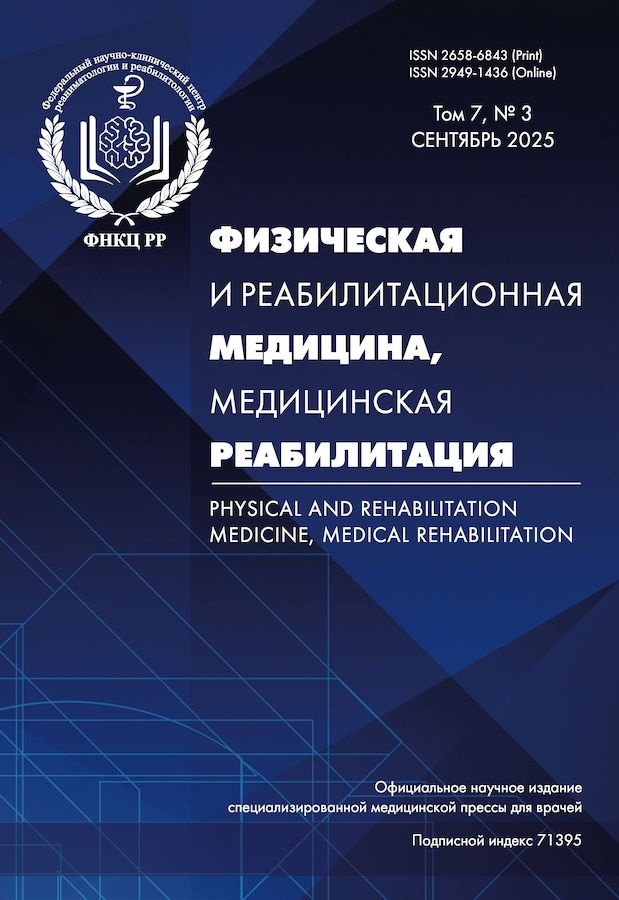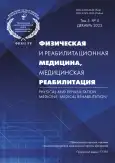Medical convergence technology in the system of comprehensive rehabilitation of children with neurotrauma: our experience of implementation (with case report)
- Authors: Valiullina S.A.1, Sidneva Y.G.1,2, Zakrepina A.V.1,3, Mamontova N.A.1, Fufaeva E.V.1
-
Affiliations:
- Clinical and Research Institute of Emergency Pediatric Surgery and Trauma
- N.N. Burdenko National Scientific and Practical Center for Neurosurgery
- Institute of Special Education
- Issue: Vol 5, No 4 (2023)
- Pages: 289-300
- Section: ORIGINAL STUDY ARTICLE
- URL: https://bakhtiniada.ru/2658-6843/article/view/249997
- DOI: https://doi.org/10.36425/rehab586480
- ID: 249997
Cite item
Full Text
Abstract
BACKGROUND: The annual increase of childhood trauma with severe consequences is 2% per year (WHO, 2020/21). This motivates rehabilitation specialists to search for new technologies and effective approaches. Timely resuscitation, early specialized and comprehensive rehabilitation care largely determine the outcome of a serious injury and prevent serious consequences. In this context, medical convergent technologies used to provide effective medical care become particularly relevant. This article of scientific, methodological and applied nature is devoted to the description of medical convergent technology implemented in the system of comprehensive rehabilitation care of children with severe neurotrauma.
AIM: The aim of the study was to substantiate and develop an effective rehabilitation technology at the level of unified (convergent) interdisciplinary managerial and clinical-diagnostic medical solutions in rehabilitation of children with severe injuries.
MATERIALS AND METHODS: Children, aged 2–17, (n=420) with consequences after severe traumatic injuries who were admitted to the Clinical and Research Institute of Emergency Pediatric Surgery and Trauma (Moscow) for treatment and rehabilitation in 2018–2022 with diagnoses: traumatic brain injury, consequences of spinal cord injury, combined trauma, mine-explosive trauma, severe skeletal trauma, infected extensive wounds. More than 300 of these patients had neurotrauma. The researchers used: literature sources on the discussed problem, findings of objective and subjective examinations (clinical examination, neuroimaging, neurofunctional, laboratory, radiation, instrumental as well as questionnaires, surveys, scales; electronic medical histories). To develop medical convergent technology, rehabilitation diagnosis, potentials and prognostic options according to the decision-making algorithm developed by physicians/specialists as well as differentiated personified rehabilitation programs were used. While developing these programs, the researchers assessed specific features of the injury, disease course, severity and level of functional impairment, activity and participation expressed in the criteria of the International Classification of Functioning, Disability and Health.
RESULTS: The researchers have enunciated the essence of the medical convergent technology in the rehabilitation of children after severe injuries as convergence, the alliance of interests from different fields, process of integration of traditional and new approaches which are united by a single goal of managing patients after severe traumatic injuries.
CONCLUSION: An interdisciplinary/multidisciplinary approach with medical convergent technology component in restoring children after severe trauma allows to optimize the rehabilitation process and the patient’s routing within this process. Integrity and continuity in management and rehabilitation of injured patients as well as step-by-step approach, help physicians to choose the most effective tactics.
Full Text
##article.viewOnOriginalSite##About the authors
Svetlana A. Valiullina
Clinical and Research Institute of Emergency Pediatric Surgery and Trauma
Author for correspondence.
Email: vsa64@mail.ru
ORCID iD: 0000-0002-1622-0169
SPIN-code: 6652-2374
MD, Dr. Sci. (Med.), Professor
Russian Federation, 22 Bolshaya Polyanka street, 119180 MoscowYulia G. Sidneva
Clinical and Research Institute of Emergency Pediatric Surgery and Trauma; N.N. Burdenko National Scientific and Practical Center for Neurosurgery
Email: ygsidneva@gmail.com
ORCID iD: 0000-0003-2733-5874
SPIN-code: 5128-9059
MD, Cand. Sci. (Med.)
Russian Federation, 22 Bolshaya Polyanka street, 119180 Moscow; MoscowAlla V. Zakrepina
Clinical and Research Institute of Emergency Pediatric Surgery and Trauma; Institute of Special Education
Email: allazakk@gmail.com
ORCID iD: 0000-0002-5757-2371
SPIN-code: 3057-2810
Dr. Sci. (Ped.); Corresponding Member of the Academy of Education of Russian Federation
Russian Federation, 22 Bolshaya Polyanka street, 119180 Moscow; MoscowNatalia A. Mamontova
Clinical and Research Institute of Emergency Pediatric Surgery and Trauma
Email: naBazarnaja@mail.ru
ORCID iD: 0000-0001-9089-8026
SPIN-code: 6364-1400
MD, Cand. Sci. (Med.)
Russian Federation, 22 Bolshaya Polyanka street, 119180 MoscowEkaterina V. Fufaeva
Clinical and Research Institute of Emergency Pediatric Surgery and Trauma
Email: Ekaterina.V.Fufaeva@yandex.ru
ORCID iD: 0000-0002-7556-0745
SPIN-code: 1561-3282
Russian Federation, 22 Bolshaya Polyanka street, 119180 Moscow
References
- Valiullina SA, Sharova EA. Epidemiological aspects of craniocerebral trauma in children with PMT. Pediatric Neurosurgery Neurology. 2012;(2-3):81–90. (In Russ).
- Catroppa C, Anderson VA, Muscara F, et al. Educational skills: Long-term outcome and predictors following paediatric traumatic brain injury. Neuropsychol Rehabil. 2009;19(5):716–732. doi: 10.1080/09602010902732868
- Catroppa C, Anderson VA, Morse SA, et al. Outcome and predictors of functional recovery 5 years following pediatric traumatic brain injury. J Pediatric Psychol. 2008;(33):707–718. doi: 10.1093/jpepsy/jsn006
- Taylor H, Swartwout M, Yeates K, et al. Traumatic brain injury in young children: Postacute effects on cognitive and school readiness skills. J Int Neuropsychol Soc. 2008;14(5):734–745. doi: 10.1017/S1355617708081150
- Baranov AA, Albitsky VY. Mortality of the child population of Russia. Moscow: Litterra; 2007. 320 р. (In Russ).
- Lavrijsen JC, van den Bosch JS, Koopmans RT, van Weel C. Prevalence and characteristics of patients in a vegetative state in Dutch nursing homes. J Neurol Eurosurg Psychiatry. 2005;76(10):1420–1424. doi: 10.1136/jnnp.2004.058198
- Vigué B, Ract C, Tazarourte K. The first 24 hours after severe head trauma. In: Annual Update in Intensive Care and Emergency Medicine 2012. Ed. J.L. Vincent. Berlin, Heidelberg: Springer, 2012. P. 772–731. doi: 10.1007/978-3-642-25716-2_65
- Agadzhanyan VV, Yakushin OA, Shatalin AV, Novokshonov AV. Significance of early interhospital transportation in complex treatment of patients with acute spine and spinal cord injury. Polytrauma. 2015;(2):14–20.
- Certificate of state registration of the database No. 2020621773. Valiullina SA, Sidneva YG, Zakrepina AV, et al. System of complex support of a child with acute traumatic injuries: An organisational model of child rehabilitation. Date of registration in the Register of databases: 01.10.2020. (In Russ). Available from: https://new.fips.ru/registers-doc-view/fips_servlet?DB=DB&DocNumber=2020621773&TypeFile=html. Accessed: 15.11.2023.
- Zakrepina AV, Sidneva YG, Bratkova MV, Valiullina SA. Mental activity of the children during the early stage of rehabilitation after acute severe brain damage. Voprosy kurortologii, fizioterapii, i lechebnoi fizicheskoi kultury. 2020;97(1):51–59. doi: 10.17116/kurort20209701151
- Ahadov TA, Semenova NA, Valiullina SA, et al. Magnetic resonance imaging in the assessment of severe craniocerebral trauma and prediction of brain recovery in children. Russ Paediatric J. 2020;23(5):291–298. doi: 10.18821/1560-9561-2020-23-5-291-298
- Certificate of state registration of the database No. 2504333. Petryaikin AV, Ahadov TA, Sidenko AV, et al. Method of visualisation of internal organs in severe trauma in children. Date of registration in the Register of databases: 20.01.2014. (In Russ). Available from: https://patenton.ru/patent/RU2504333C1. Accessed: 15.11.2023.
- Certificate of state registration of the database No. 2440025. Semenova NY, Ahadov TA. Method of diagnostics of diffuse axonal brain damage in children with craniocerebral trauma. Date of registration in the Register of databases: 20.01.2012. (In Russ). Available from: https://patents.google.com/patent/RU2440025C1/ru. Accessed: 15.11.2023.
- Turdiboev SA, Berdiev RN, Chobulov A, et al. Clinical management of traumatic intracranial hematoma in children with the position of evidence-based medicine. Vestnik Avitsenny. 2011;(3):41–44. (In Russ). doi: 10.25005/2074-0581-2011-13-3-41-44
- Nemkova SA, Zavadenko NN, Maslova OI, Karkashadze GA. Diagnosis and correction of cognitive disorders in children with traumatic brain injury consequences. Paediatric Pharmacol. 2014;11(3):54–60.
- Akhmadullina EM, Bodrova RA, Sadrieva AI. Photochromotherapy is a significant factor in complex therapy severe traumatic brain injury in children. Vestnik Novykh Meditsinskikh Tekhnologii. 2021;15(5): 83–88. doi: 10.24412/2075-4094-2021-5-3-6
- Kolykhalkina IA, Amcheslavsky VG, Ivanova TF, et al. Step-by-step therapy of intracranial hypertension in the acute period of severe mechanical trauma in children. Russ J Pediatric Surgery. 2018;22(6):296–300. doi: 10.18821/1560-9510-2018-22-6-296-300
- Certificate of Rospatent № 2022620661. Sidneva YG, Valiullina SA, Semenova JB, et al. System of neuropharmacotreatment of patients with the consequences of organic damage to the nervous system at the stages of restorative treatment and rehabilitation. (In Russ). Available from: https://new.fips.ru/registers-doc-view/fips_servlet?DB=DB&DocNumber=2022620661&TypeFile=html. Accessed: 15.11.2023.
- Certificate of Rospatent № 2018620879. Valiullina SA, Sidneva YG, Zakrepina AV, et al. System of early complex psychiatric, psychological and pedagogical rehabilitation of children with severe traumatic brain injury. Part I (reduced level of consciousness ― vegetative status, minimal consciousness). (In Russ). Available from: https://new.fips.ru/registers-doc-view/fips_servlet?DB=DB&DocNumber=2018620879&TypeFile=html. Accessed: 15.11.2023.
- Certificate of state registration of the database No. 2681712. Zakrepina AV, Bratkova MV, Mamontova NA. Method of assessing the mental activity of children with severe craniocerebral trauma. Date of registration in the Register of databases: 12.03.2019. (In Russ).
- Patent RUS 2573535 C2. Nemkova SA. Method of neurodynamic (neurosensory) correction for restoration of motor, positional, sensory and cognitive functions in patients with pathology of nervous system and musculoskeletal apparatus and suit for its application (In Russ). Available from: https://yandex.ru/patents/doc/RU2573535C2_20160120. Accessed: 15.11.2023.
- Patent RUS 2428161 C2. Kuzminova TA, Zakrepina AV, Bratkova MV. Method of restoration of motor activity and cognitive activity of children at the early stage of rehabilitation of severe craniocerebral trauma. (In Russ). Available from: https://yandex.ru/patents/doc/RU2428161C2_20110910. Accessed: 15.11.2023.
- Patent RUS 2422119 C1. Isanova VA. Method of restoration of motor functions of patients unable to move and hold a pose. (In Russ). Available from: https://yandex.ru/patents/doc/RU2422119C1_20110627. Accessed: 15.11.2023.
- Patent RUS 2703679 C2. Drokin IS, Bukhvalov OL, Sorokin SYu. Method and system for supporting medical decision making using mathematical models of patient representation. (In Russ). Available from: https://yandex.ru/patents/doc/RU2703679C2_20191021. Accessed: 15.11.2023.
- Patent RUS 2625650 C1. Zakrepina AV, Mamontova NA, Valiullina SA. Method of activation of mental capabilities in children with severe craniocerebral trauma. (In Russ). Available from: https://yandex.ru/patents/doc/RU2625650C1_20170717. Accessed: 15.11.2023.
Supplementary files








